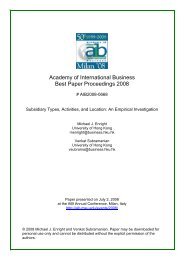AIB 2012 Conference Proceedings - Academy of International ...
AIB 2012 Conference Proceedings - Academy of International ...
AIB 2012 Conference Proceedings - Academy of International ...
Create successful ePaper yourself
Turn your PDF publications into a flip-book with our unique Google optimized e-Paper software.
TUESDAY<br />
rate index, this paper unravels an important antecedent <strong>of</strong> geographic export diversification and integrates<br />
arguments from international economics with those <strong>of</strong> international business strategies. Practitioners may gain<br />
relevant insights on the intricate performance impacts <strong>of</strong> exchange rates. (For more information, please contact:<br />
Dirk Michael Boehe, Insper Institute <strong>of</strong> Education and Research, Brazil: dirkmb@insper.edu.br)<br />
The Home Country Determinants <strong>of</strong> Outward Foreign Direct Investment from East Asia during Industrialisation<br />
Period<br />
Ling Liu, University <strong>of</strong> Edinburgh<br />
This article examines the home country macroeconomic determinants <strong>of</strong> outward foreign direct investment from<br />
Japan, Korea and China during their industrialization period. Error Correction Model is used to test relationships<br />
between OFDI and explanatory variables in the long run and short run. The results show that the three<br />
countries converge on the same macroeconomic variables GDP per capita, human capital and exports, indicating<br />
that firms are engaging in FDI as a response to export performance through economic development. The<br />
regression results show that the three countries exhibit different relationship with foreign exchange reserves,<br />
exchange rates and interest rates. Japan's OFDI is affected by interest rates in the long run, Korea by exchange<br />
rates and China by foreign exchange reserves in both the long and short run. This implies that limited<br />
differences do still exist across the three countries. (For more information, please contact: Ling Liu, University <strong>of</strong><br />
Edinburgh, United Kingdom: ling.liu@ed.ac.uk)<br />
Country <strong>of</strong> Origin and Behavior <strong>of</strong> Institutional Investors: Evidence from Japan<br />
Ralf Bebenroth, Kobe University<br />
Nir Kshetri, University <strong>of</strong> North Carolina<br />
This paper investigates whether country <strong>of</strong> origin and behavior <strong>of</strong> institutional investors matter for acquisitions<br />
in Japan. We investigate how the post-acquisition performance <strong>of</strong> target firms differs across domestic versus<br />
foreign and friendly versus unfriendly institutional takeovers. In applying the arms-length principle and<br />
geographic proximity theory, our results partly confirm that Japanese target firms acquired in an unfriendly<br />
attempt performed better right after the deal. Subsequently, performances were significantly higher for target<br />
firms acquired by foreign institutional investors compared to domestic ones. The number <strong>of</strong> employees after the<br />
deal decreased strongly for Japanese and for friendly attempts but increased for foreign and unfriendly ones.<br />
Implications are discussed. (For more information, please contact: Ralf Bebenroth, Kobe University, Japan:<br />
rbeben@rieb.kobe-u.ac.jp)<br />
Drivers <strong>of</strong> Korean Exports: Testing the Influence <strong>of</strong> Governance Structure and Managerial Orientation<br />
Young Soo Yang, Yonsei University<br />
Yong Suhk Pak, Yonsei University<br />
Young-Ryeol Park, Yonsei University<br />
Determinants <strong>of</strong> internationalization through export have been perpetually examined for the Korean-context due<br />
to her export-driven economy. Despite the fact that prior literature focused on firm- or managerial-level<br />
analysis, a very distinctive ownership structure <strong>of</strong> Korean firms such as family- and chaebol-ownership has been<br />
barely examined and needs further clarification on its influence on exports. Also, little research attempted to<br />
examine whether outside directors have adequate knowledge and information to make meaningful contributions<br />
to exportation. As a result, this paper extends the study <strong>of</strong> export behavior <strong>of</strong> Korean firms by highlighting<br />
managerial experience <strong>of</strong> outside directors and governance structure <strong>of</strong> Korean firms. We tested the drivers <strong>of</strong><br />
Korean exports using the samples <strong>of</strong> 453 Korean manufacturing firms which are listed in the Korean Stock<br />
Exchange (KSE) from 2005 to 2008. The results showed that the international experience <strong>of</strong> top managers and<br />
the distinctive Korean governance structure, Chaebol, positively affected internationalization through export,<br />
while family-owned enterprises was negatively associated with exportation. The contribution <strong>of</strong> outside directors<br />
<strong>AIB</strong> <strong>2012</strong> <strong>Conference</strong> <strong>Proceedings</strong><br />
Page 237

















